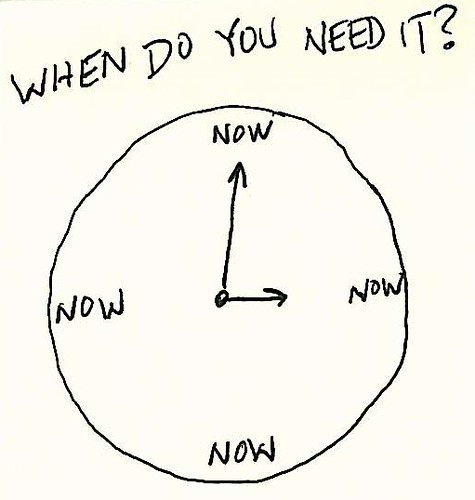|
|
|
Tuesday, November 26th, 2019
Scheduling is every boss’ responsibility.
Good scheduling means your people can count on having a life outside work.
If projects stack up, or have deadlines like these, you need to figure out what’s going on.

Don’t look to your team for a solution.
In most cases, look in the mirror to solve the problem.
Image credit: Dan4th Nicholas
Posted in Culture, Motivation, Retention | No Comments »
Monday, October 7th, 2019

Poking through 13+ years of posts I find information that’s as useful now as when it was written.
Golden Oldies is a collection of the most relevant and timeless posts during that time.
I love being vindicated (again). When I wrote this in 2015 I took a lot of ribbing from my young techie friends, who saw tech as the only road to the good life, while liberal arts was the road to oblivion. That was the story being hyped by most media, too. I never bought it, nor did Nick Kristof, who said as much in no uncertain terms in his column The New York Times. Nothing has changed, as you’ll see tomorrow.
Read other Golden Oldies here.
I constantly read/hear that if you want your kids to have a good life focus on a purely STEM curriculum and they’ll be home free.
Moreover, if they are great at coding they don’t even need college.
While it may be true, at least at this point in time, that they can get a good job if they have strong coding skills, what they are unlikely to get is a promotion that takes them beyond coding, whether in a technical or leadership/management role.
Pulitzer Prize winner (twice) Nicholas Kristof, a columnist for The New York Times, with 1.4 million followers on Twitter, 1.3 million followers on Google+ and 600,000 followers on Facebook (click ‘more’ to see his bio) sums up the value of a humanities, AKA, liberal arts, degree 1, 2, 3.
First, liberal arts equip students with communications and interpersonal skills that are valuable and genuinely rewarded in the labor force, especially when accompanied by technical abilities.
My second reason: We need people conversant with the humanities to help reach wise public policy decisions, even about the sciences.
Third, wherever our careers lie, much of our happiness depends upon our interactions with those around us, and there’s some evidence that literature nurtures a richer emotional intelligence.
Even the most rabid coders don’t want to do it for 40 years.
But if your knowledge of society is limited to code and your ability to interact with others is negligible, then you are left with little choice.
Even a degree in STEM or business won’t give you the broad outlook or emotional intelligence it takes to be promoted, let alone start a successful company.
The best way to assure yourself a bright future, whether you decide to code or earn a “useful” degree, is to patronize your library as so many “self-made” folks did/do
Stay away from your area of expertise, instead wander sections of which you have no knowledge, select books randomly and read at every opportunity.
Image credit: Susanne Nilsson
Posted in Personal Growth | No Comments »
Friday, December 7th, 2018
 (click to enlarge) A Friday series exploring Startups and the people who make them go. Read all If the Shoe Fits posts here.
Bias is in our heads. Bias is in our MAP (mindset, attitude, philosophy™).
Bias totally permeates us and the rest of society.
It’s embedded in our schools, our religions and all forms of AI.
Experts, educators, gurus, and pundits analyze it, write about it, consult about it, and coach on it.
And often contradict each other.
If bias is this pervasive, the experts so ineffectual and management so ambivalent, what can one person do on their own?
You can access your MAP (mindset, attitude, philosophy™) where bias lives.
No one else can, only you.
That means you can change your MAP.
No one else can, only you.
One bias at a time.
Image credit: School of Thought
Posted in Personal Growth | No Comments »
Monday, December 11th, 2017
It’s amazing to me, but looking back over more than a decade of writing I find posts with information that is as useful now as when it was written.
Golden Oldies is a collection of what I consider some of the best posts during that time.
Considering the forced use of technology in schools, with the exception of the schools to which the tech honchos send their kids, and the insistence that the best (only?) path to success is found through STEM, I thought this would a great time to reprise a slightly heretical post from 2015 focused on the value of (gasp) liberal arts. Not only does it increase EQ, lib arts will make you one of the few who can actually carry on a face-to-face conversation.
Read other Golden Oldies here.

I constantly read/hear that if you want your kids to have a good life focus on a purely STEM curriculum and they’ll be home free.
Moreover, if they are great at coding they don’t even need college.
While it may be true, at least at this point in time, that they can get a good job if they have strong coding skills, what they are unlikely to get is a promotion that takes them beyond coding, whether in a technical or leadership/management role.
Pulitzer Prize winner (twice) Nicholas Kristof, a columnist for The New York Times, with 1.4 million followers on Twitter, 1.3 million followers on Google+ and 600,000 followers on Facebook (click ‘more’ to see his bio) sums up the value of a humanities, AKA, liberal arts, degree 1, 2, 3.
First, liberal arts equip students with communications and interpersonal skills that are valuable and genuinely rewarded in the labor force, especially when accompanied by technical abilities.
My second reason: We need people conversant with the humanities to help reach wise public policy decisions, even about the sciences.
Third, wherever our careers lie, much of our happiness depends upon our interactions with those around us, and there’s some evidence that literature nurtures a richer emotional intelligence.
Even the most rabid coders don’t want to do it for 40 years.
But if your knowledge of society is limited to code and your ability to interact with others is negligible, then you are left with little choice.
Even a degree in STEM or business won’t give you the broad outlook or emotional intelligence it takes to be promoted, let alone start a successful company.
The best way to assure yourself a bright future, whether you decide to code or earn a “useful” degree, is to patronize your library as so many “self-made” folks did/do
Stay away from your area of expertise, instead wander sections of which you have no knowledge, select books randomly and read at every opportunity.
Image credit: Susanne Nilsson
Posted in Golden Oldies, Personal Growth | No Comments »
Wednesday, April 22nd, 2015

I constantly read/hear that if you want your kids to have a good life focus on a purely STEM curriculum and they’ll be home free.
Moreover, if they are great at coding they don’t even need college.
While it may be true, at least at this point in time, that they can get a good job if they have strong coding skills, what they are unlikely to get is a promotion that takes them beyond coding, whether in a technical or leadership/management role.
Pulitzer Prize winner (twice) Nicholas Kristof, a columnist for The New York Times, with 1.4 million followers on Twitter, 1.3 million followers on Google+ and 600,000 followers on Facebook (click ‘more’ to see his bio) sums up the value of a humanities, AKA, liberal arts, degree 1, 2, 3.
First, liberal arts equip students with communications and interpersonal skills that are valuable and genuinely rewarded in the labor force, especially when accompanied by technical abilities.
My second reason: We need people conversant with the humanities to help reach wise public policy decisions, even about the sciences.
Third, wherever our careers lie, much of our happiness depends upon our interactions with those around us, and there’s some evidence that literature nurtures a richer emotional intelligence.
Even the most rabid coders don’t want to do it for 40 years.
But if your knowledge of society is limited to code and your ability to interact with others is negligible, then you are left with little choice.
Even a degree in STEM or business won’t give you the broad outlook or emotional intelligence it takes to be promoted, let alone start a successful company.
The best way to assure yourself a bright future, whether you decide to code or earn a “useful” degree, is to patronize your library as so many “self-made” folks did/do
Stay away from your area of expertise, instead wander sections of which you have no knowledge, select books randomly and read at every opportunity.
Image credit: Susanne Nilsson
Posted in Personal Growth | No Comments »
Wednesday, November 12th, 2014

I said yesterday I’d provide a simple way to get back in sync with your people.
It’s not rocket science and certainly not new.
In fact, I’ve been telling managers for decades that if they want to know what someone thinks or wants to ask, instead of assuming or “figuring it out.”
They rarely listen, so I thought that if it came from Dan Amos, chairman and chief executive of Aflac, the giant insurance company it would carry more weight.
Aflac chief Amos admits his solution sounds obvious: If you want to know what would keep someone from quitting, ask. “It sounds like common sense, but not many companies really do it.”
I’ve also been saying that money is around five on most people’s list; making a difference, recognition, challenge and opportunities to learn and grow come first.
Employers often assume, Amos says, that everyone will just want more money. But most people’s wish lists are more complicated — and more realistic — than that. Amos started polling Aflac’s employees when he became CEO in 1990. The top requests: More recognition for their work and day care for their kids.
Many companies survey their people.
The difference is that Amos acts on the results of the survey—both requests were implemented — not just in the home office, but across the country (read the article).
Amos says that “the survey rules” and the proof is found in ease of recruiting and turnover numbers.
That willingness to listen has helped Aflac — the only insurance company to show up in Fortune’s Best Companies ranking for 13 years running — to successfully recruit talented women from all over the U.S. and from as far away as India.
It also, apparently, builds loyalty: Aflac’s annual employee turnover is pretty close to zero.
Flickr image credit: Aflac
Posted in Compensation, Culture, Motivation, Retention | No Comments »
Monday, April 9th, 2012
In an interesting post at HBR Peter Bregman talks about attending a conference as yourself instead of as your role, although roles are far easier, because we feel more comfortable and safer.
It’s why, within a minute of meeting someone, we begin to define ourselves by our roles, our status, and our relationships to others. We think it’s because other people need that information to know us.
But standing alone at that party I realized I’d been fooling myself. Other people don’t need that information to know me. I need that information to know myself.
I would go further and suggest that you attend life as yourself as opposed to your roles.
Roles make it easy to interact with strangers, but they also allow us to hide from our bosses, colleagues and even serve as barriers between us and our families—but the greatest disservice roles perform is allowing us to hide from ourselves.
If you define yourself internally by your roles you preclude exploration and the chance to discover new depths, travel new paths and learn what you are really capable of.
Putting yourself first and your roles second is scary and makes you vulnerable, but it also opens the door to a myriad of possibilities.
Flickr image credit: sxc.hu
Posted in Personal Growth | No Comments »
Friday, January 29th, 2010
 Engaging your people is a priority these days, but to do it you must foster an environment of trust, where the messenger is never killed and people feel safe saying what they really think. It also helps if you have the kind of ego that doesn’t stand on its dignity. Engaging your people is a priority these days, but to do it you must foster an environment of trust, where the messenger is never killed and people feel safe saying what they really think. It also helps if you have the kind of ego that doesn’t stand on its dignity.
Here is one approach.
Start with how many times you have said or heard people say ‘should have’, as in “We should have…” or “My boss should have…?”
What if you could harness the creativity behind those thoughts to improve performance in an organization (whether team, executives or somewhere in-between)—the company’s; the group’s; the individual’s; your own?
The idea is to take that “should have’ attitude and make it a constructive function to foster corporate/personal growth and motivation, since the more comprehensive the view of their job and company the more creative people will become.
Drawing in all your people, no matter their level, encourages them to see a larger picture, juices creativity, surfaces ideas from unlikely sources and enhances their sense of ownership, i.e., engagement.
Improvement happens because how they think is the basis for how they perform.
If your MAP makes you the type of manager to whom this appeals then encourage your people to ask
- “Why did she do that?”
- “What can I learn from his decision?”
- “What would I have done differently?”
- Later ask, “Would it have worked?”
Discuss the responses and implement the insights.
For more great stuff on engagement, click over to Becky Robinson’s LeaderTalk for a roundup of articles on engagement from some terrific bloggers.
Image credit: HikingArtist on flickr
Posted in Business info, Communication, Culture, Leadership | No Comments »
Thursday, November 12th, 2009
 Recently Dan McCarthy wrote 10 Ways to Get the Most from a 360 Degree Leadership Assessment and it’s really good stuff. Recently Dan McCarthy wrote 10 Ways to Get the Most from a 360 Degree Leadership Assessment and it’s really good stuff.
But the thoughts and actions that Dan recommends could just as easily be called ’10 ways to get the most from any feedback you receive.”
And I do mean any—feedback from bosses, peers and subordinates, of course, but also from spouses/partners, kids, close and extended family, friends, acquaintances and even strangers with whom you interact.
I recently told a client this and she was surprised. She said that most were logical and she sort of understood including acquaintances, but strangers made no sense to her.
So I explained.
Most people, most of the time, have the most positive interactions with those with whom we are close; in other words, we’re on our best behavior.
Sure, we may disagree, yell, fight, say unpleasant things on occasion, but, by and large, people are on their best behavior the closer the relationship.
That’s why many managers check to see how candidates treat the receptionist when they come in for interviews. I know of many times that managers rejected a strong candidate because of admin feedback. The feeling is that if they are rude to the admin they won’t play well on the team.
Strangers don’t think about giving feedback, but you do get reactions. It may only be a look that is gone in a flash, but that doesn’t lessen its value as feedback.
That means you need to stay aware of the reactions of the people around you, but that isn’t likely to happen when you’re intently focused or upset, which is when you’ll get the most feedback—often negative.
But what you don’t notice the people you hang with will, so ask them for feedback. Ask widely, ask often, listen well and then apply Dan’s 10 points, tweaked as needed for the situation.
Image credit: Rocket-Sputter on flickr
Posted in Business info, Communication, Motivation, Personal Growth | No Comments »
Monday, April 6th, 2009
 An interesting post from Steven Vannoy and Craig Ross talks about the need of so many to “fix it” no matter what ‘it’ is, but especially when it comes to other people’s actions. They offer the ‘4 A’s— awareness; acceptance; ask; acknowledge’—as a more successful approach when change is needed. Good stuff and well worth reading. An interesting post from Steven Vannoy and Craig Ross talks about the need of so many to “fix it” no matter what ‘it’ is, but especially when it comes to other people’s actions. They offer the ‘4 A’s— awareness; acceptance; ask; acknowledge’—as a more successful approach when change is needed. Good stuff and well worth reading.
But before you put it into practice take a step back and ask yourself this question.
Is my goal to help X change for the better or help X to do it the way I do it?
Think of all the times you’ve made suggestions to someone on a different/better way to do something when, in fact, the different/better way was the way you do it.
The fix-it syndrome lives in all of us, especially managers and in most cases people are honestly trying to help. It’s not a case of ‘my way or the highway’, just the feeling that their approach is the best one around.
And it is—for them.
So next time you want to fix-it be sure that what you’re fixing is really an improvement and not just the difference between your way and a different way.
Image credit: sxc.hu
Posted in Business info, Communication, Culture, Motivation, Personal Growth | No Comments »
|
 Subscribe to
Subscribe to
MAPping Company Success
About Miki 
Clarify your exec summary, website, etc.
Have a quick question or just want to chat? Feel free to write or call me at 360.335.8054
The 12 Ingredients of a Fillable Req
CheatSheet for InterviewERS
CheatSheet for InterviewEEs™
Give your mind a rest. Here are 4 quick ways to get rid of kinks, break a logjam or juice your creativity!
Creative mousing
Bubblewrap!
Animal innovation
Brain teaser
The latest disaster is here at home; donate to the East Coast recovery efforts now!
Text REDCROSS to 90999 to make a $10 donation or call 00.733.2767. $10 really really does make a difference and you'll never miss it.
And always donate what you can whenever you can
The following accept cash and in-kind donations: Doctors Without Borders, UNICEF, Red Cross, World Food Program, Save the Children
*/
?>About Miki
About KG
Clarify your exec summary, website, marketing collateral, etc.
Have a question or just want to chat @ no cost? Feel free to write
Download useful assistance now.
Entrepreneurs face difficulties that are hard for most people to imagine, let alone understand. You can find anonymous help and connections that do understand at 7 cups of tea.
Crises never end.
$10 really does make a difference and you’ll never miss it,
while $10 a month has exponential power.
Always donate what you can whenever you can.
The following accept cash and in-kind donations:
|










 Engaging your people is a priority these days, but to do it you must foster an environment of trust, where the messenger is never killed and people feel safe saying what they really think. It also helps if you have the kind of ego that doesn’t stand on its dignity.
Engaging your people is a priority these days, but to do it you must foster an environment of trust, where the messenger is never killed and people feel safe saying what they really think. It also helps if you have the kind of ego that doesn’t stand on its dignity. Recently Dan McCarthy wrote
Recently Dan McCarthy wrote 

